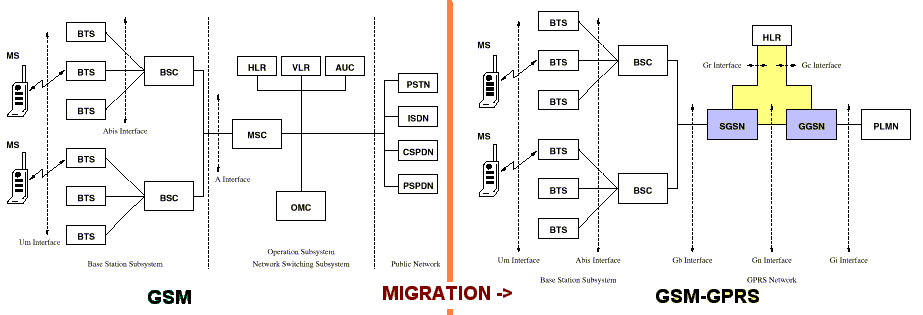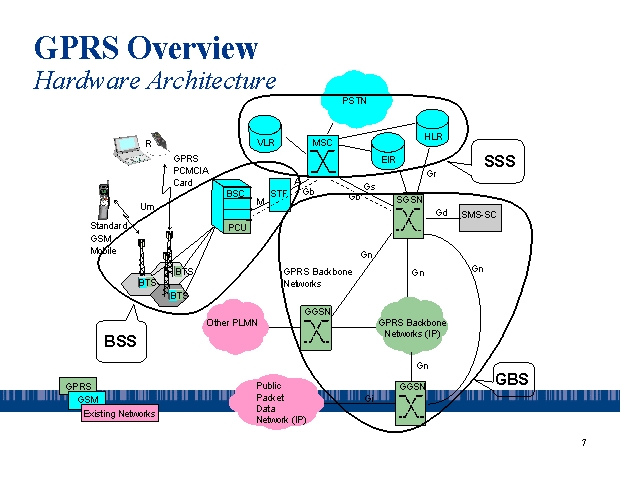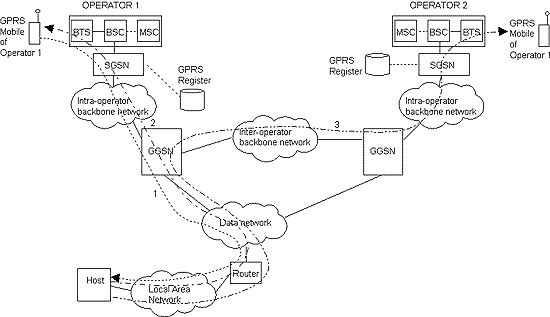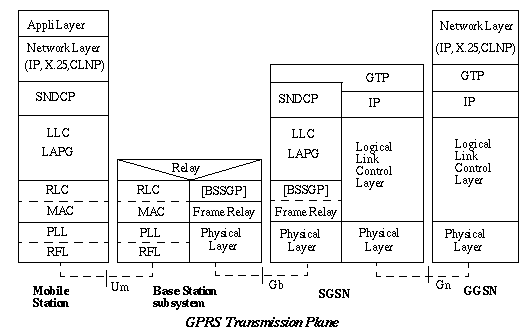
| The Mobile Communication's Area | Attached you will find a lot of things that make mobile communications possible. This is my actual job's area. GSM Network System and UMTS Software Development. I will try to give you some Intro about GPRS, the second communication's generation which based on GSM. To find out what GSM or UMTS means, please refer to the appropriate included links. For those wo want more infos. please e-mail me, i hope i will help you (Mail-me) as far as possible.
| | GPRS (General Packet Radio Services) what's that ? The maximum user data rate provided by the current GSM data services which are based on circuit switching technology is only 9.6 kbps. To enable support of new data applications and user requirements with higher data rates, EuropeanTelecommunications Standards Institute(ETSI)in its GSM phase 2+ development is working towards two new GSM data services - High Speed Circuit Switched Data (HSCSD) and General Packet Radio Service (GPRS). HSCSD is an enhancement of the current circuit switched GSM data services to cover higher user rates than 9.6 kbps. The architecture of HSCSD service is based on the physical layer of the current data services. The increased user rate is achieved by using multiple TDMA time slots for a connection unlike current GSM data services which uses one TDMA time slot. GPRS is a new GSM data service that provides actual packet radio access for mobile GSM users. The main purpose of GPRS, like other packet data services, is to efficiently accomodate data sources that are bursty in nature. The packet - oriented GPRS network infrastructure introduces new functional elements and the concept of mobility management is changed. Features of GPRS * Supports user data rates more than 9.6 kbps.
* Efficiently accomodates data sources that are bursty in nature.
* Uses packet switching technology.
* Provides better utilisation of the transmission medium than circuit switched technology; the transmission medium is used only on demand and with statistical multiplexing, one physical channel can be shared by many users.
* Allow charging depending on the amount of data transmitted and the quality of service negotiated.
* Makes possible for GSM license holders to share physical resources on a dynamic, flexible basis between packet data services and other GSM services.
* Shares GSM frequency bands with telephone and circuit switched data traffic, and makes use of many properties of the physical layer of the original GSM system, most importantly the TDMA frame structure,modulation technique and structure of GSM time slots.
* Offers connection to standard data networks using protocols such as TCP/IP,X.25 and CLNP. | | Applications of GPRS The range of possible applications of GPRS covers simple distribution and messaging services as well as advanced retrieval and conferencing services that provide multidirectional communication via real time information ransfer between multiple users.
* Wireless Personal Computers or Mobile Offices(Internet Surfing, File Transfer, E-mail, Telnet, Video Conferencing)
* Telematics(Fund Transfer, Alarm Notification)
* Road Traffic and Transport Informatics(Automatic Debiting, Route Guidance, Fleet Management); GPRS Services GPRS will offer data transfer capabilities between two MSs or between an MS and various terminals, attached to either the GPRS network or the external public data networks (PDNs). Types of services supported :
* Point-to-point (PTP) services
* Point-to-mutipoint (PTM) services The PTP service will be offered either connectionless or connection oriented. The first type is a datagram service, intended to support bursty non-interactive applications based on the connectionless network protocol according to ISO 8473 Connectionless Network Protocol (CLNP) or the Internet Protocol (IP) defined by Request for Comments (RFC) 791. With this service, single and independent packets are sent from a single subscriber to a ingle destination user. The second type of service provides a logical relationship between users and is intended to support bursty transactional or interactive applications based on X.25 or the Connection-Oriented Network Protocol(CONP) according to 8348. The PTM service enables the transmission of a single message to multiple subscribers. Data transmission to multiple destinations is initiated by a single service request. The PTM service is subdivided into a multicast (PTM-M) and a group call service (PTM-G). Multicast means the message is addressed to all subscribers in a geographical area. The message contains a group identifier,indicating whether the message is of interest to all subscribers or only a subset belinging to a specific PTM group. With PTM-G only a predefined group of subscribers controlled by a multicast server will receive the message transmitted. | 
Since GSM has been designed for circuit switched transmission only, introduction of a packet switching techinique obviously evokes some significant functional and operational changes. A new logical network node called the GPRS support node (GSN) is introduced in order to create an end-to-end packet transfer mode. Physically, the GSN can be integrated with the mobile switching center (MSC) or it can be a separate network element based on the architecture of data network routers.
GSN is a mobility router that provides connection and interworking with various data networks, mobility management with the GPRS registers and the delivery of data packets to MSs, independently of their location.
The Gateway GSN (GGSN) acts as a logical interface to external packet data net- works. The GGSN updates the location directory using routing information supplied by the SGSNs about an MS's path and routes the external data network protocol packetencapsulated over the GPRS backbone to the SGSN currently serving the MS. It also decapsulates and forwards external data network packets to the appropriate data network and handles the billing of data traffic.
| 
The Serving GSN (SGSN) is responsible for the delivery of packets to the MSs within its service area. The main functions of the SGSN are to detect new GPRS MSs in its service area, handle the process of registering the new MSs along with the GPRS registers, send/receive data packets to/from the GPRS MS and keep a record of the location of MSs inside of its service area. The subscription information is stored in a GPRS register where the mapping between a mobile's identity (such as MSISDN or IMSI) and the PSPDN address is stored. The GPRS register acts as a database from which the SGSNs can ask whether a new MS in its area is allowed to join the GPRS network. For the coordination of circuit and packet switched services, an association between the GSM MSC and the GSN is created.
This association is used to keep routing and location area information up to date in both entities. Furthermore, it enables comb- ined GSM /GPRS attachment as well as paging of circuit switched calls within the GPRS network. Exchange of short messages via GPRS is considered by connecting the GSM SMS-MSC to the SGSN, too. Although transmission of packetised speech would be possible, this has been outside the scope of GPRS thus far.
| 
| The mobile IP (mobile extension of IP) does not meet the GPRS requirements exactly,mainly because non-Internet packet data protocols (PDPs)like X.25 are not supported. Nevertheless, the GGSN and SGSN can be considered counterparts of the mobile IP (MIP) home and foreign agents. Data Packet Routing in GPRS Three different scenarios in the routing of data packets between a fixed host and a GPRS MS are illustrated below: Mobile-Originated (path 1), Mobile-Terminated when the MS is in its home network (path 2) and Mobile-Terminated when the MS has roamed to another GPRS operator's network (path 3). In these examples, the operator's GPRS network consists of multiple GSNs (ie. GGSN & SGSN) and an intra-operator backbone network. The intra-operator network connects the support nodes of one operator-specific network protocols that can be different for each operator. With interworking capabilities,the GGSN can be connected to data networks and to an inter-operator backbone network that connects the GPRS networks of different operators using one standard protocol.
| 
| In the first case of mobile-originated transmission, the SGSN encapsulates the incoming packets and routes them to the appropriate GGSN, where they are forwarded to the correct PDN. PDN-specific routing procedures are applied to send the packets to the corresponding host inside PDN. Packets coming from a corresponding host are routed to the GGSN through the PDN based on the examination of the destination address. The GGSN checks the routing context associated with the destination address and determines the SGSN's address and the relevant tunneling information. The packet is encapsulated and forwarded to the SGSN, which delevers it to the MS. Similiar explanations can be given to the other cases. The GPRS network encapsulates all data network protocols into its own encapsulation protocol. This is done to ensure security in the backbone network and to simplify the routing mechanism and the delivery of data over the GPRS network. Because the GPRS network is not sensitive to the data protocol employed (with the exception of corresponding GGSN), it is possible to add support for other data network protocols in the future with minimum changes in the GPRS system.
| | The GPRS data communication architecture adheres to the well known principle of protocol layering and distinguishes between two protocol planes. The signaling plane consists of protocols that control and support the transmission of user information. The GPRS-relevant functions are connection control, routing and mobility management. The transmission plane covers the protocols for user information trans- mission and associated control procedures like flow control or error handling. Data Transmission The following figure shows the proposed transmission plane up to layer 3 according to the ISO/OSI reference model. Above this layer, widespread standardised protocols may be used. The selection of these protocols is outside the scope of GPRS specification. | 
| Between two GSNs, the GPRS Tunnel Protocol (GTP) tunnels the PDUs through the GPRS backbone network. The GTP header contains a tunnel end-point identifier for point-to-point and multicast packets, a group identifier for point-to-multipoint packets, a type field for PDU type specification and a quality of service (QoS) parameter . Below GTP, IPv4 is used as a GPRS backbone network layer protocol. Dep- ending on the operator's network architecture, Ethernet cabling, ISDN links or ATM based protocols may be used below IP. Between the SGSN and MS, further encapsulation is performed by the subnetwork dependent convergence protocol (SNDCP) that maps network level protocol char- acteristics onto the underlying logical link control and provides multiplexing of multiple layer 3 messages onto a single virtual logical link connection. Ciphering , segmentation and compression functionality are also covered by SNDCP. The BSS GPRS protocol (BSSGP) has been derived from BSSMAP already used in GSM and conveys routing and QoS related information between BSS and SGSN. The BSSGP
operates above frame relay. Radio communication between the MS and the GPRS network covers physical and data link layer functionality. Data Link Layer Between the MS and BSS, the data link layer has been separated into two distinct sublayers : - The logical Link Control (LLC) layer
- The Radio Link Control/Medium Access Control (RLC/MAC) sublayers
The LLC layer is the higher sublayer of the data link layer. It operates above the RLC/MAC layer and provides a logical link between the MS and SGSN. Protocol functionality is based on link access procedure-D (LAPD) used within the GSM sig- naling plane with support for PTM transmission. According to common terminology, the protocol is called Link Access Procedure on the G-channel (LAPG). The RLC/MAC layer provides services for information transfer over the physical layer of the GPRS radio interface. It defines the procedures that enable multiple MSs to share a common transmission medium which may consist of several physical channels. The RLC layer is responsible for the transmission of data blocks across the air inter- face and the backward error correction (BEC) procedures consisting of selective retransmission of uncorrectable blocks. The MAC sublayer itself is derived from a slotted ALOHA protocol and operates between the MS and the BTS. It is responsible for access signaling procedures for the radio channel governing the attempts to access the channel by the MSs and the con- trol of that access by the network side. It performs contention resolution between channel access attempts, arbitration between multiple service requests from different MSs and medium allocation to individual users in response to service requests. Physical Layer The physical layer is split up into two sublayers : - Physical link sublayer (PLL)
- Physical RF sublayer (RFL)
The PLL provides services for information transfer over a physical channel between the MS and the network. These functions include data unit framing, data coding and the detection and correction of physical medium transmission errors. The PLL uses the services of the physical RFL. The PLL performs : - Forward error correction (FEC) coding allowing detection and correction of errors in transmitted codewords and the signaling of uncorrectable codewords.
- Rectangular interleaving of one radio block over four bursts in consecutive TDMA frames.
- Procedures for detecting physical link congestion.
The RFL is part of a complete GSM system that delivers a range of services including GPRS. The RFL performs the modulation and demodulation of the physical wave- forms and conforms to the GSM 05 series of recommendations which specifies : - Carrier frequencies and GSM radio Channel structures (GSM 05.02)
- Modulation of transmitted waveforms and the raw data rates of GSM channels (GSM 05.04)
- Transmitter and receiver characterisctics and performance requirements
(GSM 05.05) Signaling Between the MS, BSS and SGSN the same protocols are used as for data transmission up to the SNDCP protocol. Only at the network layer a specific mobility management protocol (MMP) is required within MS and SGSN to support the mobility function- ality.Between the SGSN and MSC , an extended BSSAP is used instead of TCAP in the standard SS7 stack. Between the SGSN and HLR/SMS-MSC the standard SS7 stack is retained except that the MAP is extended according to GPRS mobility management. | |